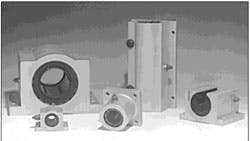Linear rolling-element bearings
The next few columns will discuss linear rolling-element bearings, particularly those using ball-type rolling elements.
Q: I’m familiar with lubrication requirements of ball and roller bearings for rotary motion. Are the requirements of linear rolling-element bearings any different?
A: With the ball-type linear bearings we’ll be discussing here, you have the choice of lubricating with oil or light grease or, in some situations, even running dry. The many pockets in the bearing’s retainer hold an ample supply of oil or grease.
Most applications call for a lubricant to prevent wear of the highly polished bearing surfaces and to prevent rusting. For high linear speed and heavy load, lubricate with a light oil. In less severe conditions, use a medium-heavy oil or light grease. These lubricants have greater surface adhesion than a light oil, and afford longer protection and help prevent sealing problems.
You can run some linear bearings without lubricant in some low-speed, lightly loaded applications, or if the environment is contaminated with particles. However, you must periodically inspect dry-running bearings to ensure troublefree operation.
Q: I’ve heard of self-aligning bearings, some of them called “super-type” bearings. What are they and where can I use them?
A: A “super-type” bearing is a self-aligning bearing that can accommodate slight misalignment (up to 0.5 deg) between bearing and shaft.
Individual bearing plates can pitch fore and aft, evenly distributing loads on the bearing balls while accommodating deviations in shaft straightness or slight misalignment of bearing housings. In most designs, a plastic retainer holds bearing plates in place. However, if the application temperature is too high for polymer retainers, or if precision and rigidity take precedence over self-alignment and load capacity, use all-steel bearings.
For typical applications, self-aligning bearings offer higher load capacity and longer travel life than conventional (steel) linear bearings.
Next: More about linear rolling-element bearings.
